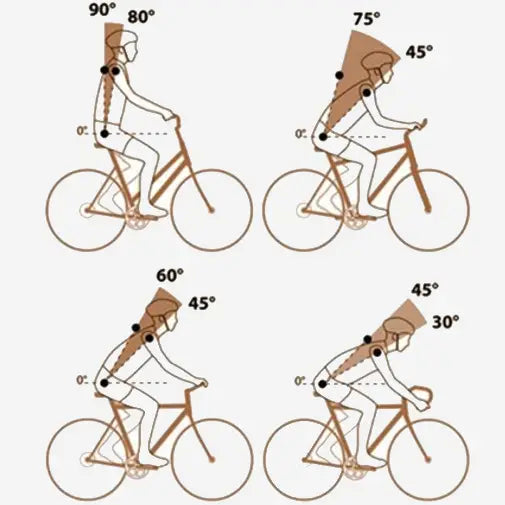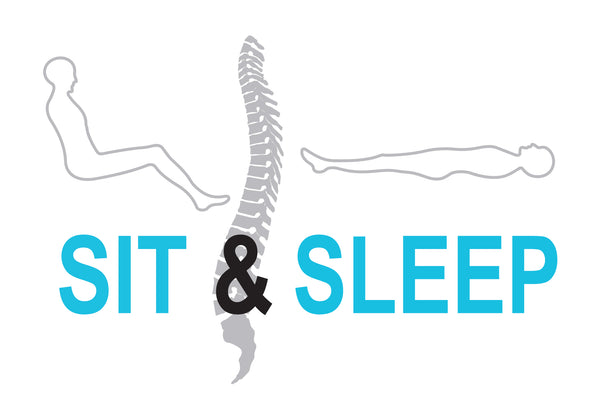
Ergonomic cycling
Cycling is the perfect combination of exercise and enjoying nature. Yet, many cycling enthusiasts experience discomfort while cycling. Pain during or after cycling can be annoying, and continuing to cycle with discomfort can have long-term consequences and often take away the enjoyment of cycling.
If you want to cycle comfortably and enjoyably, it's crucial to have the correct riding position. There are several parts of your bike you need to consider, and the correct riding position depends on your riding style and therefore every type of cyclist is different.
There are general tips to properly adjust your bicycle ergonomically in advance, and there are common complaints for which the solution often lies within the correct adjustment.
BASIC POSTURE
Always maintain good basic posture. If your spine forms a slight S-shape while cycling, your pelvis is in the right position. Always try to cycle dynamically by alternating different positions while cycling, especially over longer distances. This activates as many muscles as possible and provides variety. The strain on your hands, buttocks, and feet, which occasionally relieves some of the strain on your muscles. According to experts, incorrect pelvic positioning can cause pain elsewhere in the body.
The hands are in an ideal position on the handlebars when the forearm and hand are in a straight line and the wrist is not bent. The nerves of the wrist, which pass through the carpal tunnel, are then in a neutral position and free of compression or pain.
INSTITUTIONS
Ideal upper body position begins on the saddle. Your bottom should rest stably on the saddle, with your sit bones resting on the wide part. The first step is to adjust the saddle height in relation to the pedals. The saddle should be high enough to allow you to rotate your legs smoothly. If your saddle is too low, you won't be able to extend your legs properly and you won't use your muscle power efficiently. If your saddle is too high, you'll overextend your knees or ankles, or you'll slide around on your saddle to reach the pedals. The correct seat height primarily determines the position of your pelvis and the load on your knees, while seat depth primarily determines the load on your shoulders and arms. When you've determined the correct seat height and depth and grip the handlebars, your shoulders should be relaxed and low. Your arms should be slightly bent downward.
SADDLE
Your saddle is at the correct height when your toes just touch the ground. When the pedals are horizontally at the same height, your front knee is directly above the pedal axle. This is the best position to exert force without putting excessive strain on your knee. This is the starting point for the saddle's seat depth. Your kneecap should be above the pedal axle and the ball of your foot.
SEND
Determine the ideal handlebar position by sitting on the saddle in a cycling position and then swinging your arms forward in a relaxed manner. Your hands should be able to rest on the grips. To sit deeper, the handlebars should be both lower and further away. You can adjust the height by raising or lowering the stem. Adjusting the handlebars forward or backward is done by tilting the adjustable stem or by replacing the stem. Your upper body position should not be altered by sliding the saddle forward or backward, keeping your arms slightly bent downward. Hold the handlebars but do not lean on them.
COMMON COMPLAINTS DUE TO WRONG SETTINGS
SADDLE PAIN
Saddle pain is one of the most common complaints. If you're just starting out, cycling can take some getting used to, but saddle height and width often play a significant role. With a saddle that fits your hip width and the correct saddle height, you should quickly experience fewer problems. Pain in your seat or back can occur if your saddle is set too high, has an unfavorable angle, or simply isn't suitable for your body. You can solve this by adjusting the saddle height or angle, or by purchasing a new saddle (for example, a gel saddle or a special women's saddle).
KNEE PAIN
Knee pain in cyclists generally arises in three areas: irritation around the kneecap, irritation around the patellar tendon, and irritation on the outside of the knee (also known as runner's knee). The complaints are often a combination of an incorrect saddle adjustment and a rapid buildup of stress while cycling. If you don't look for a solution, the pain can worsen, manifesting as discomfort during, but especially after, cycling. The correct saddle position, combined with gradually increasing resistance and cycling in a lighter gear, can reduce pressure on the knee.
Pain in your knees and feet is caused by your saddle being set too low or your feet not being positioned properly on the pedals. You can solve this by adjusting the saddle height and/or paying attention to your foot placement on the pedals.
PAIN IN LOWER BACK WHILE CYCLING
Back pain can arise from continuous pressure and tension in the long back muscles. This causes back muscle fatigue and pressure on the intervertebral discs. Increasing cycling load too quickly or changing posture too rapidly can cause back pain. Adjusting your cycling position can reduce the pressure on your back. Consider:
- Adjusting the distance between the saddle and handlebars.
- Raising the handlebars.
- Adjusting the angle of the saddle.
Pain in your seat or back can occur if your saddle is set too high, tilted unfavorably, or simply not suitable for your body. You can solve this by adjusting the saddle height or tilt, or by purchasing a new saddle (for example, a gel saddle or a special women's saddle).
Numbness
Numbness in the hands and wrists while cycling often occurs due to pressure on the nerve in the wrist caused by an abnormal position of the forearm and wrist. If the nerves and vessels in the wrist are permanently bent in an unnatural manner, tingling or numbness may occur.
Hand and wrist problems can also arise from a tense posture on the bike. This compresses a nerve in the neck/shoulder. The less you lean forward, the less the muscles in your neck and upper back have to work. Raising the handlebars and/or adjusting the distance between the handlebars and saddle can help you sit more upright, relieving pressure on your upper back and neck. Overextended arms put too much strain on them, and if your handlebars and/or grips aren't properly shaped, you'll experience painful hands. You can resolve this by changing your posture by adjusting your handlebar position, handlebar shape, and/or grips.
NECK AND SHOULDER COMPLAINTS
Neck and shoulder pain usually occurs when your handlebars are too close or too far from your saddle, or when your handlebars are too wide or too narrow. You can solve this by adjusting your stem length and/or purchasing new handlebars. Do you tend to hunch your shoulders, or do you have to stretch to reach the handlebars? Here are some possible solutions:
- Slide your bike saddle slightly forward on the rails. Or back if the handlebars are too close to your body.
- Tilt your handlebars. By tilting the bend in the center of the handlebars, you can bring the grips closer to your body, or further away.
Bike fitting
Looking for a place to have your bike tuned? You can search for "Bike Fitting" or visit the websites of Energy Lab or Bike Power Leuven, for example, to schedule an appointment.





